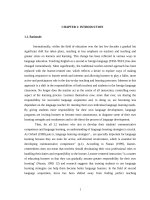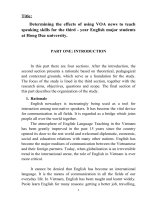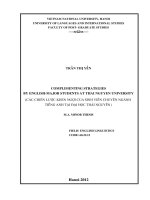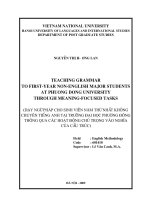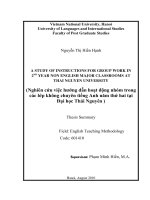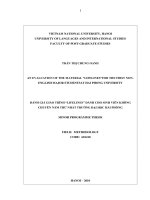Using popular culture in teachinh video for english major students at thang long university
Bạn đang xem bản rút gọn của tài liệu. Xem và tải ngay bản đầy đủ của tài liệu tại đây (1.14 MB, 11 trang )
Kỷ yếu công trình khoa học 2015 - Phần II
USING POPULAR CULTURE IN TEACHING VIDEO FOR
ENGLISH MAJOR STUDENTS AT THANG LONG UNIVERSITY
Le Thi Tuyen (M.A)
English Department, Thang Long University
Email:
Abstract: In the field of language teaching, one of the major targets is to prepare
students for real-life situations which they may encounter on an everyday basis. Every
English teacher aspires to provide their students with essential language skills that they can
use in their future lives and careers. A traditional English class mostly contains presentation
and practice of grammar, vocabulary and pronunciation. Although it is undeniable that these
fundamental elements are of great importance, without which hardly any students can go very
far, there is a need to provide students with more complex information and experience that
enable students to interact with native English speakers and in native English environment. It
is vital for non-native students to be aware of how real native speakers of English use the
language and how they incorporate it in their lives. Therefore, this article aims to discuss the
necessity of using videos of popular culture as a source of teaching material in order to
create a more engaging and realistic learning environment. It will first provide an overview
of popular culture and video teaching as well as their key components. Then it will discuss
some practical experiences of bringing pop culture videos to the classroom of the author, its
effectiveness as well as the students’ feedback.
Key words: Pop Culture, teaching video, ESL class, teaching material.
1. Introduction
A common feedback that English teachers receive nowadays is that their lessons
contain too much practice of grammar, vocabulary and pronunciation and lack of real usage of
native speakers of English (Nguyen, 2014). In addition, in the time where students have more
access to media, especially social media, and also opportunities to travel, the criticism of the
conventional English lesson has become tougher than ever since students notice that there are
huge differences between what they learn in their textbooks and what they see on TV or gain
from their reading experience (Ronayne, Shayne & Nguyen, 2012). Hence, there is an
increasing demand of incorporation of forms of culture within classroom time in order to
provide students with more real sources of English. This makes popular culture an ideal
source and material for the EFL classroom, as it not only allows students to listen to standard
language but also provides examples of colloquial language in more authentic, less artificial
situations than a textbook.
Understanding these changes and demands in the field of teaching foreign languages
in general and English in particular, English Department has used videos in teaching English
since 2006. Each week, English major students have two-hour lecture of video for four
consecutive semesters from English 2 to English 6, using two video series New Headway and
Lifetime composed by Oxford University Press. It is noted that Thang Long University is the
only university who offers such kind of video lessons in English major curriculum. Thus, both
teachers and students found it very innovative, interesting and motivating with video lessons.
However, the problem is that these books are now rather out of date since they were published
Trường Đại học Thăng Long
155
Kỷ yếu công trình khoa học 2015 - Phần II
in 1998. Being a video teacher for 8 years, the author has noticed that students have shown
less enthusiasm and engagement in these video books in the last four and five years. It is not
difficult for us to understand this fact since the widespread of YouTube and other worldwide
reality shows and programs give students so many chances to get access to interesting and
popular videos. Therefore, the author deeply understands that if she kept teaching the only 4
or 5-minute video in a 2- hour- lecture, students would lose their enjoyment and soon fall
asleep. After doing a lot of reading and search, videos of popular culture comes to the author
as a new approach to tackle the problem.
2. Literature Review
2. 1. Definition of popular culture
The term ‘popular culture’ was coined in the 19th century. Back to that time, popular
culture was associated with poor education and the lower classes, as opposed to the ‘official
culture’ and higher education of the upper classes (Storey, 2006). However, with the
widespread of industrialization in the 20th century and the technology age in the 21st century,
‘popular culture’ has been widely used in every walk of life.
According to Milestone and Meyer (2012), popular culture is an “amorphous concept”
(2012, p.1) and the term “popular culture” has been defined in numerous ways. Mukerji and
Schudson view popular culture as “the beliefs and practices, and the objects through which
they are organized, that are widely shared among a population. This includes folk beliefs,
practices and objects rooted in local traditions, and mass beliefs, practices and objects
generated in political and commercial centers.” (Mukerji &Schudson, 1991, p.3). This can be
understood that popular culture is something related directly to the mainstream society.
Sharing the same ideas, but Bates and Ferri provide an easy-understanding definition of
popular culture:
“Popular culture is the television we watch, the movies we see, the fast food, or
slow food, we eat, the clothes we wear, the music we sing and hear, the things we spend our
money on, our attitude toward life. It is the whole society we live in, that which may or may
not be distributed by the mass media. It is virtually our whole world”
(Bates & Ferri, 2010, p.3)
Storey (2006) defines popular culture as “mass culture”, which is mass-produced for
mass consumption. It is “the culture that is left over after we have decided what high culture
is” (p.5). Popular culture, therefore, can be seen as a residual category, which consists of
practices that fail to meet the required standards to qualify as high culture. However, Ray B.
Browne, a famous theorist of popular culture, asserts that “it is a grave mistake to assume that
all creators of the popular arts achieve no worthwhile standards” (Browne, 2006, p.79).
According to him, any form of popular culture is valuable because it represents the voice of
the people, their likes and dislikes, the lifeblood of daily existence, their way of life, and only
by conducting research into popular culture products in an objective and non-judgmental
manner, can we understand and appreciate the value of popular culture (p.76).
2.2. The benefits of using popular culture videos as a source of language teaching
The benefits of using authentic material coming from songs, TV shows and movies in
the EFL classroom have been widely researched. A number of researches have revealed that
Trường Đại học Thăng Long
156
Kỷ yếu công trình khoa học 2015 - Phần II
these sources of teaching material appear to be effective tools for language learners
(McKinnon, 2010; James, 2011; Huang, 2005; Vélez, 2004; Washburn, 2001).
MacKinnon (2010) describes popular culture videos as a “valuable classroom tool”
(p.10) because the content that is called “viral” spreads faster than the flu. Pop culture videos
have a great deal of appeal since they are funny, even downright hilarious sometimes and
their special feature is shareability. With just a click of a mouse you can share an image or
video with all of your contacts. They, in turn, share it with theirs and so the content spreads.
Moreover, these viral, funny or popular videos never fail to engage students, especially young
learners and teenagers. There is no doubt that once teachers can engage their students in the
learning activities, the students must be eager and enthusiastic to learn (Weedon, 2010)
The natural style of language usage occurred in movies and television may be more
useful for communicative learning than fictitious texts that appear in several textbooks
(Quaglio, 2008). According to Carter and McCarthy (1995), in order to effectively foster
speaking skills, it is essential that the material should focus on spoken, instead of written,
English, and there is a huge gap between real life conversations and textbook dialogs. In
addition, Vietnamese learners, for instance, are not always exposed to spoken English outside
of the classroom; therefore, a dependence on textbook English may not sufficiently prepare
learners for understanding in real life conversations. Therefore, there is a need for instructors
to bring television dialogs into the classroom as a viable alternative because these dialogs are
a rich source of authentic material and thus particularly valuable for pragmatic teaching and
learning (Washburn, 2001). As Katchen (2003) revealed these dialogs are “made to sound
natural to native speakers” so in this respect, they represent authentic language. One may
argue that the language used in all these popular culture products is scripted, so they may
appear not truly authentic. However, in comparison to the stagnant written language found in
textbooks, the language usage in these cultural products offer much better sense of real
conversations.
Furthermore, particularly in the context of Vietnam where low motivation often poses
a challenge to the language classrooms, using popular culture videos as a source of teaching
material may motivate students because of its entertaining features. Once students can engage
themselves with the material, it may encourage them to study better. A considerable amount
of research has shown that “positive attitude and motivation are closely related to success in
learning a second language” (Bai, 2008, p. 12).
In addition, the usage of popular culture videos in the language classrooms can
provide Vietnamese learners with a window to look into societies of different English
speaking countries. The situations portrayed in movies, TV shows and the language used in
them give students a way into understanding cultural phenomena of other countries. One may
argue that these cultural products reveal several features of a foreign culture, but this cultural
understanding may not be apparent to non-native speaker who are not familiar with the
language or the culture. However, thanks to globalization as well as the friendly setting and
the global features presented in these products, a non-native learner can easily compare and
relate to their personal experience
3. Winning strategies in ESL video lessons
Trường Đại học Thăng Long
157
Kỷ yếu công trình khoa học 2015 - Phần II
As stated in the previous part of the article, video lessons give ESL students a wealth
of learning opportunities. However, since there are now incredibly rich sources of different
videos available on the Internet, it has posed a question of choosing the most ‘suitable’ one
for your students. To answer this question, the author wants to share her own experiences in
her video class.
Tip 1: Understand your students
As a teacher, you should understand your students’ language level, background, age
and liking because it helps you to choose the video of appropriate level of language and
interesting topics. For example, last semester the author taught first year English major
students who mostly at the age of 18 years old and their language level is pre-intermediate.
After the quick questionnaire in the class, the author found out that her students really like the
videos of the following topics:
•
•
•
•
•
•
•
•
Music
Fashion
Hobby
Love
Friendship
Beauty
Food and Drink
Travelling
Tip 2: What’s you teaching goal?
To really tap into the potential of video lessons, the teaching activities must be
targeted to your goals. There are two layers to video lessons. One is related to your teaching
goals. Will you show your students a video for listening, vocabulary, grammar practice or just
an ice-breaking activity? What is the language element you want them to learn?
Tip 3: Well-preparation
The second layer of a video lesson is the structure of the lesson itself. Even if you are
sure you want to show a video to improve listening comprehension, it is not as simple as just
pressing “play” button. Each video lesson must be accompanied by its own lesson plan, and
the lesson plan must be targeted to meet your teaching goals. Each video lesson plan must
include three basic components as follows:
• Pre-viewing activities: The pre-viewing activities would be like the warm-up
exercise that we usually have for other types of activities
• Viewing activities: Viewing activities consist of tasks that students must complete
while watching the video
• Post-viewing activities: Post-viewing activities are a nice way to wrap-up the
video lesson and a great opportunity to consolidate everything your students have learned in a
production or performance activity.
(See Appendix A for an example of a video lesson that the author has applied in her
class)
Trường Đại học Thăng Long
158
Kỷ yếu công trình khoa học 2015 - Phần II
Tip 4: varies the class activities
As young learners are more likely to get bored easily if they are asked to do same kind
of activities everyday, teachers should vary the class activities in all pre-viewing, viewing and
post-viewing step. Ferlazzo (2012) shares that designing different class activities in different
stages of the lesson not only make students motivated but also make them learn in different
ways. In some cases, student’s personal taste can make them less interest in one activity, but
find themselves eager in other activities.
The author will share her own experiences in designing different class activities with
pop culture videos in the next part of the article.
4. How to use pop culture video in your classroom
There are many things teachers can do with these videos. Hereby the author would like
to demonstrate the most effective and easy-applied activities that she has used in the her video
class.
4.1. Split viewing
Some students see and hear a sequence; others only hear it. A variety of activities can
then follow based on an information-gap procedure. For example, those students who see and
hear the clip from the movie Pearl Harbour are eyewitnesses to the dramatic event; the others
are journalists working for a radio station who have to conduct a live interview. This is
particularly good for past tenses and pre-intermediate levels above.
Another version of split viewing is ‘Back to the Screen’. The teacher picks a short
engaging clip from a movie and then divides the class into pairs, with one group facing the
TV and the other with their back to it. Then, after turning off the sound, the teacher begins
playing the movie. The person who can see the screen tells the other person what is
happening. Then, after a minute or a few minutes (depending upon the length of the video),
the students switch places. Afterward, the pairs write a chronological sequence of what
happened, which is shared with another group and discussed as a class. Finally, everyone
watches the clip, with sound, together.
4.2. Vision on/ Sound off
Students view a scene with the sound turned off. They then predict the content of the
scene, write their own script and perform it while standing next to the television. After the
performances students watch the scene with the sound on and decide which group was the
funniest or the nearest to the original. This activity is very graphic with plenty of gestures to
stimulate the imagination.
4.3. Observe and write
Students view a scene (this always works better if there is a lot happening) then write a
newspaper article on what they have witnessed. Another application of this kind of activity is
watching a movie and write a review about the film, but watching film is a time-consuming
activity, so it is advisable to assign this activity as a homework.
4.4. Video dictogloss
This follows the dictogloss method of dictation and can easily be adapted to video.
Students watch the scene a few times and write the main words and short phrases that a
Trường Đại học Thăng Long
159
Kỷ yếu công trình khoa học 2015 - Phần II
particular character says. Each group is given a character and is encouraged to listen and
exchange information. This usually works better if there are two characters in the scene.
Working with someone from a different group, they then write the script for the scene,
incorporating both characters. As they will not have managed to write down the whole script
from the listening exercises they will have to use their imagination and fill in the gaps. This
gives them an excellent opportunity to work on grammar.
4.5. Watch and observe
This is a good lesson for lower levels because students only have to focus on a
minimum of spoken dialogue. Students watch a scene from a film which has lots of things
that they can see and therefore write in their vocabulary books. You can teach and test your
students’ vocabulary by asking a series of true/ false questions and asking them to put a series
of events in order.
4.6. Video as a tool to practice conversations
Video as a listening tool can enhance the listening experience for our students. We
very rarely hear a disembodied voice in real life but as teachers we constantly ask our students
to work with recorded conversations of people they never see. This is often necessary in the
limited confines of the language school and sometimes justifiable, for example, when we give
students telephone practice. However, we can add a whole new dimension to aural practice in
the classroom by using video. The setting, action, emotions, gestures, etc, that our students
can observe in a video clip, provide an important visual stimulus for language production and
practice. This exercise involves working with a conversation as a jumbled text first then using
the movie to check. Conversations normally have a logical order and movies are a great
source. There is a role-play which encourages students to practise conversational English.
4.7. Watch and Questions
Another way to use video to generate student thinking involves students watching a
short video clip and then writing questions about the clip. Students divide into pairs, exchange
their papers, and answer their partner's questions. We can also develop this activity to the
whole class ranging from easy to difficult questions. This kind of activity can help students
develop critical thinking.
(See the Appendix B for useful website for popular culture video)
5. Conclusion
In a nutshell, researches have revealed that popular culture videos can be used as an
excellent vehicle for teaching in the EFL classroom because they provide a more authentic
language resource when compared with textbook instruction, and perhaps most importantly it
increases students’ motivation and engagement into the learning process. Once students feel
they can engage themselves with the learning material, it will increase their willingness to
study. They are more likely to benefit not only from the process of studying but such kind of
English class also provides them with multiple layers of cultural and social phenomena.
Indeed, the feedbacks on a course questionnaire completed at the end of the semester were
extremely positive. Comments have included: “I look forward to coming to class every week
because the video is a great fun and I learn a lot about the world”, “I really think my listening
has improved after listening to different English accents.” The author was especially
Trường Đại học Thăng Long
160
Kỷ yếu công trình khoa học 2015 - Phần II
impressed, happy and motivated with the comment from one student that “I like the way you
use videos with us -- you get us moving, talking, writing and speaking. The problem is you
make us think too much."
6. REFERENCES
[1]. Bates, S. & Ferri, A.J. (2010). What's Entertainment? Notes Toward a Definition
in Wilcox, R. V., College, G. (eds.) Studies in Popular Culture, 33(1), pp.1-21.
[2]. Burke, D. (1998). Without slang and idioms, students are in the dark! ESL
Magazine, September/October. Available from
/>3. Carter, R., & McCarthy, M.(1995). Grammar and spoken language. Applied
Linguistics 16, pp.141-158.
4. Ferlazzo, L. (2012). Eight ways to use video with English language learners.
Available from:
/>5. Huang, C. (2005). Effective EFL education through popular authentic materials.
ELT Journal, 7, pp. 90-101.
6. James, C. (2011). How to teach English as a foreign language (EFL), using DVDs
of TV shows and movies. Available from:
language-efl-using8084786.html
7. Katchen, J. E. (2003). Teaching a listening and speaking course with DVD films:
can it be done? In H. C. Liou, J. E. Katchen, & H. Wang (Eds.), Lingua Tsing Hua, pp. 221236 Taipei: Crane.
8. Maltby, R., & Craven, I. (1995). Hollywood cinema: An introduction. Cambridge,
MA: Blackwell.
9. Mckinnon, M. (2010). Teaching technologies: teaching English using video.
Available from:
/>10. Milestone, K. & Meyer, A. (2012). Gender and Popular Culture. Polity Press.
11. Mukerji, Chandra & Schudson (eds.) (1991). Rethinking Popular Culture:
Contemporary Perspectives in Cultural Studies. Berkeley: University of California.
12. Quaglio, P. (2008). Television dialogue and natural conversation: Linguistic
similarities and functional differences. In A. Ädel & R. Reppin (Eds.), Corpora and discourse:
The challenges of different settings (Studies in corpus linguistics, 31, pp. 189-210.
Amsterdam: John Benjamins.
13. Ronayne, M., Shayne, J. & Nguyen, J. (2012). Meeting in the middle: making use
of popular culture in the classroom. Pedagogy and the Human Sciences, 1, no.2, pp. 22- 32.
14. Storey, J. (2006). Cultural Theory and Popular Culture. Pearson Education. ISBN
978-0-13-1970687.
15. Vélez, R. (2004). From couch potatoes to critical learners: A theoretical
Trường Đại học Thăng Long
161
Kỷ yếu công trình khoa học 2015 - Phần II
framework for television use in EFL/ESL classrooms. Available from:
/>16. Washburn, G. (2001). Using situation comedies for pragmatic language teaching
and learning. TESOL Journal, 10, pp. 21-26.
17. Weedon, T. (2010). Exploring popular culture in education. Available from:
/>18. Widdowson, H.G. (1990). Aspects of language teaching. Oxford: Oxford
University Press.
Tóm tắt: Trong lĩnh vực giảng dạy ngôn ngữ, một trong những mục tiêu quan trọng
hàng đầu là phải chuẩn bị cho sinh viên những tình huống thực tiễn mà các em có thể gặp
phải trong cuộc sống hàng ngày. Giáo viên tiếng Anh nào cũng mong muốn cung cấp cho
sinh viên của mình những kỹ năng ngôn ngữ cần thiết để các em có thể sử dụng trong cuộc
sống và công việc trong tương lai. Tuy nhiên ở các lớp học tiếng Anh truyền thống chủ yếu
giáo viên giới thiệu kiến thức và sau đó cho sinh viên luyện tập ngữ pháp, từ vựng và phát âm.
Mặc dù không cần phải bàn cãi rằng đây đều là những nội dung vô cùng quan trọng, thiếu
những nội dung này, hiếm có sinh viên nào có thể tiến xa hơn trong việc sử dụng ngoại ngữ,
nhưng những lớp học này cũng cần cung cấp cho sinh viên những thông tin và trải nghiệm
phức tạp hơn để giúp các em sinh viên có thể giao tiếp và tương tác với người bản ngữ hoặc
trong môi trường bản ngữ. Đối với những sinh viên này, việc nắm bắt được cách sử dụng
tiếng Anh của những người nói tiếng Anh bản ngữ là vô cùng quan trọng. Vì thế, mục tiêu của
bài viết là thảo luận tầm quan trọng của việc sử dụng các video mang nội dung văn hoá đại
chúng làm tài liệu giảng dạy để tạo ra một môi trường học tập có tính gắn kết và thực tiễn
hơn. Trước hết, bài viết sẽ đưa ra tổng quan về văn hoá đại chúng, việc dạy video và các
thành phần chính của chúng. Trong phần tiếp theo, bài viết sẽ thảo luận những kinh nghiệm
thực tiễn trong việc lồng ghép các video văn hoá đại chúng vào lớp học của tác giả bài viết,
tính hiệu quả cũng như những phản hồi từ sinh viên.
Trường Đại học Thăng Long
162
Kỷ yếu công trình khoa học 2015 - Phần II
APPENDIX A
Trường Đại học Thăng Long
163
Kỷ yếu công trình khoa học 2015 - Phần II
APPENDIX B
Useful website for popular culture videos
Trường Đại học Thăng Long
164
Kỷ yếu công trình khoa học 2015 - Phần II
Beside the use of YouTube, let’s try the following links
1. Educational websites
/>
/>2. Famous TV shows
/> /> /> />3. Music and films
/> /> /> /> />
Trường Đại học Thăng Long
165

